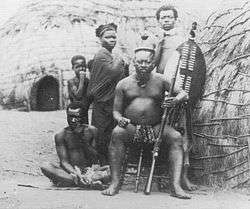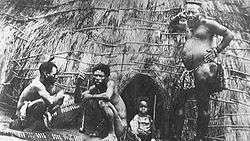Ntshingwayo Khoza
Ntshingwayo kaMahole of the Khoza (1809–1883) was the commanding general [isiZulu: inDuna] of King Cetshwayo's Zulu Army during the first Anglo-Zulu War. He became known as Ntshingwayo kaMahole after being taken into foster care by Mahole of the Khoza.

Ntshingwayo was given overall field command of the Zulu impi against the Centre Column of the first British invasion of Zululand in the Anglo-Zulu War of 1879. Despite conflicting orders - to meet the British Army's Centre Column in open battle "and eat them up" [kill them], but also a private command from Cetshwayo "not to go to the English at once [to attack], but to hold a conference first and send some chiefs to the English to ask why they were laying the country waste and killing Zulus",[1][2] Ntshingwayo successfully outmanoeuvred Lt. Gen. Lord Chelmsford in the field. Chelmsford had split the British contingent, sending out a large part of his forces on patrols from the main British camp at Isandlwana in an effort to find the Zulu army, leaving the camp poorly defended and unfortified. Ntshingwayo's amabutho [isiZulu: "regiments"; singular: ibutho] attacked and virtually annihilated the encamped British Army in the Battle of Isandlwana on 22 January 1879. With a death toll of some 1,300 British troops, locally conscripted volunteers, native soldiers and camp followers, the British Army suffered the bloodiest defeat by a native force in its history and the worst defeat of the Victorian era.
Despite the overwhelming victory, and Ntshingwayo's competent command of the battle, the King was extremely displeased at the great number of Zulu casualties at Isandlwana. It will never be known how many casualties the Zulus suffered, but several hundred were killed and many more wounded. Modern historians suggest a total casualty figure of some 1,000 Zulus is not unreasonable.[2] Two of Ntshingwayo's own sons who fought in the battle were badly wounded. Sishishili kaMnqandi, a royal favourite and an induna [isiZulu: "officer"] of the uKhandempemvu ibutho who the King had asked to report on the battle, placed the blame for the lack of the Zulu army's preparation and the resulting high death toll squarely at the door of Ntshingwayo, who forfeited much of the public acclaim he was due for his great victory. Yet the blame for the outcome is arguably King Cetshwayo's, since he gave conflicting orders to Ntshingwayo to not attack the British until after negotiations. In the event, the Zulu surprise was so complete that they had little choice but to engage the British where they found them on the field.[2]

After King Cetshwayo's return to Zululand from captivity in Cape Town and England, many of his most loyal supporters gathered to greet him, including Ntshingwayo kaMahole. The King's return was divisive, causing a polarisation between the royalist and anti-royalist factions. Many of his followers launched an attack on Prince Zibhebhu kaMaphitha of the Mandlakazi collateral Zulu royal family branch, who had oppressed the Cetshwayo's followers during the King's absence. Zibhebhu was an iqawe [isiZulu: "renowned warrior", "hero"], a veteran of Isandlwana who lead the Zulu reserve which accounted for many of the dead fugitives from the British camp, and would prove to be the greatest Zulu general since Shaka. He lured them into a trap and defeated them in an ambush in the Msebe valley. In fear for his safety, the King called up his old amabutho, veterans of Isandlwana. Amongst them was Ntshingwayo. This was a flagrant violation of the British laws which had been enforced in Zululand in the wake of the war and which firmly prohibited any raising of Zulu forces.[2]
On 21 July 1883, Zibhebhu launched a surprise attack on the royal homestead of King Cetshwayo at oNdini (near present day Ulundi) which was undergoing renovations at the time. Seasoned amabutho of the battle of Isandlwana met Zibhebhu in open battle, but they were soundly defeated. Hundreds were trapped in the homestead and slain, including Ntshingwayo's siblings Hayiyana and Makhoba. In the incident the king was himself wounded by a spear and fled the scene of the bloody coup. Ntshingwayo was one of the King's many senior induna who were run down and killed as they tried to escape,[2] along with Ntshingwayo's childhood friend Godide Ndlela. oNdini was razed to the ground.
The great irony is that the victorious general of Isandlwana was himself killed by a fellow veteran of the battle.[2] Today Ntshingwayo is traditionally regarded as a Zulu hero.
Further reading
- Ron Lock and Peter Quantrill. Zulu Victory – The Epic of Isandlwana and the Cover-Up; ISBN 1-85367-645-4
- Ian Knight. Zulu Rising: The Epic Story of Isandlwana and Rorke's Drift; London, 2010. ISBN 0-330-44593-6.